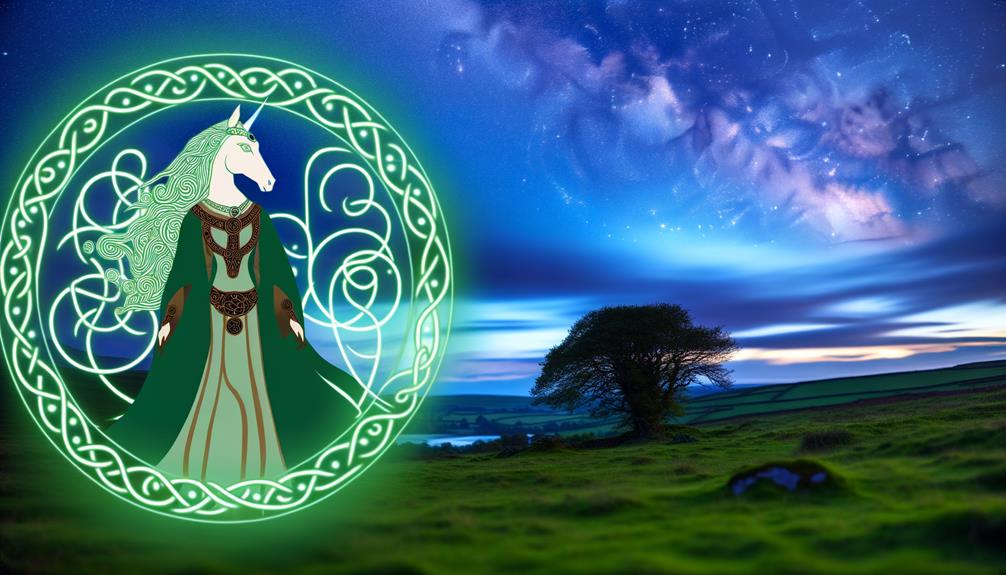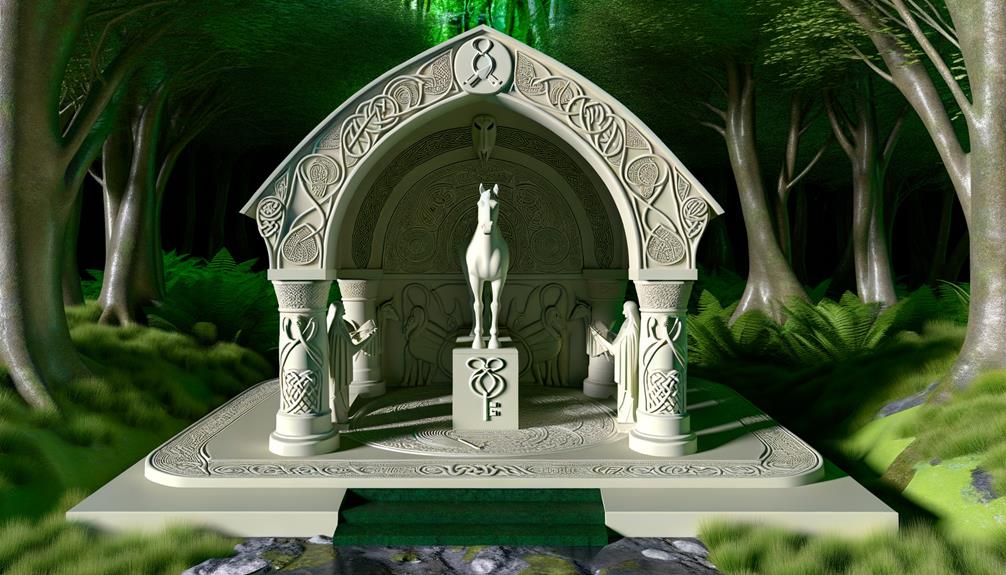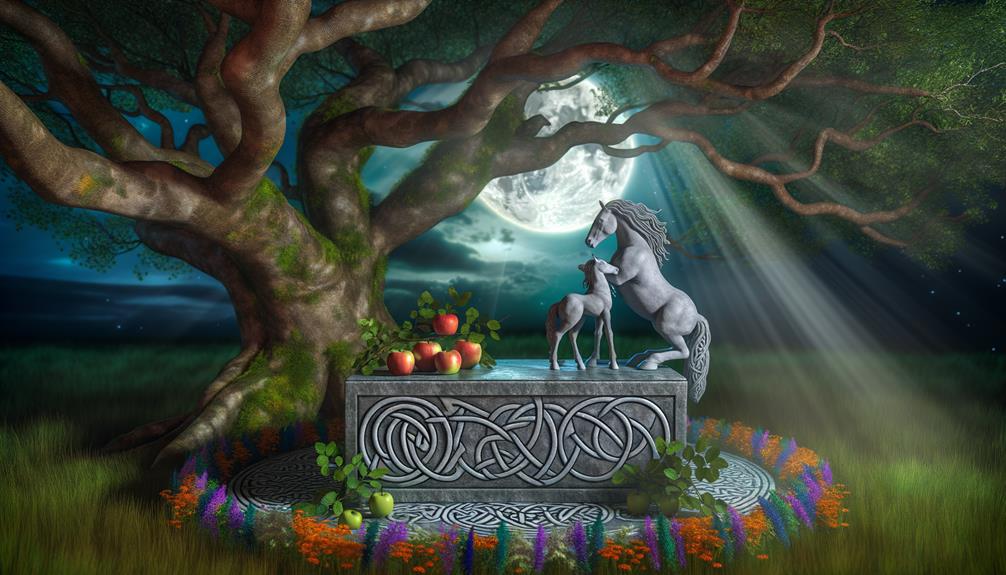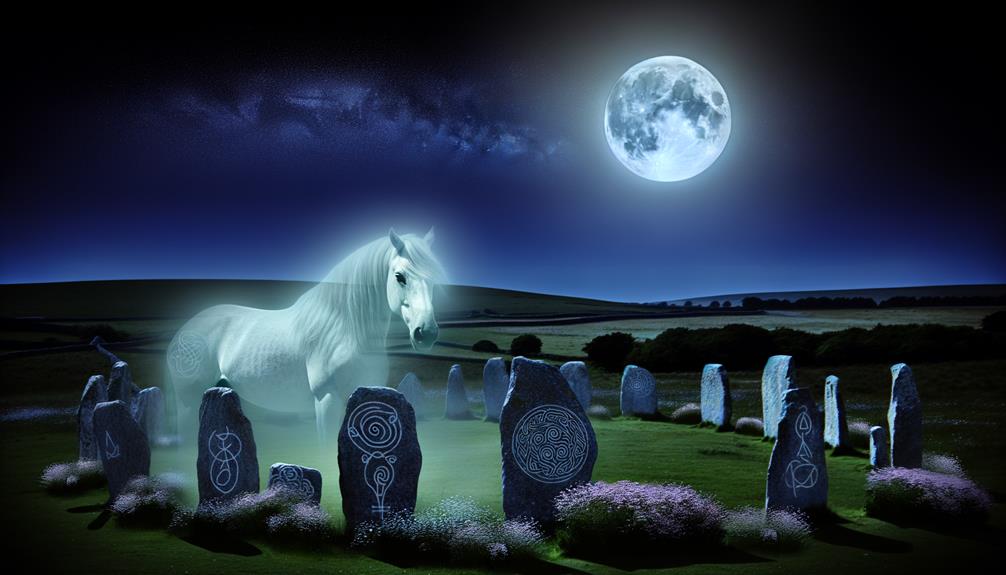The admiration and reverence for Epona, the horse goddess, is a tale as old as time, deeply etched into the fabric of human and horse relations. My research into the scarce historical and archaeological records of this enigmatic deity, revered as a fertility symbol and horse protector in the Gallo-Roman belief system, has been a significant undertaking. Even though there are no precise myths about her, her presence is palpable in ancient art and literature, often paired with horse emblems, hinting at her widespread influence. This study aims to dig deeper into the mysteries surrounding the practices, gifts, and pictorial representations related to Epona's worship. Can you imagine what intriguing revelations we might stumble upon concerning our forebears' spiritual ties to the natural world?
Origins of Epona Worship

Let's talk about the origins of Epona worship. Epona, known as the Greek Goddess of fertility and the defender of horses, played a crucial role in the Gallo-Roman religion. This religion was a mix of Celtic and Roman Hellenic customs. As the Horse Goddess, Epona gained a lot of followers, especially from those whose lives depended on horses. But it wasn't just the Roman cavalry who worshipped her. Mule drivers and scouts also sought her protection. While there aren't many concrete myths about her, Epona's beginnings can be seen in both art and literature. This proves how important she was. Her name, which means 'Great Mare' in Gaulish, shows her deep connection with horses. Today, her worship still exists among neo-druids, pagans, and polytheists, showing her lasting impact.
Epona's Role in Celtic Mythology

Celtic mythology is a fascinating world, where Epona shines as a goddess revered for her ties to fertility and safeguarding horses, ponies, donkeys, and mules. Known as the guardian of these creatures, she also held the title of Gaul's horse goddess.
Epona's worship and symbolism have a strong connection to the region of the Roman Cavalry. Her images often depict her as the Great Mother and often feature her with a Roman Emperor's Horse.
- Epona's link to the Roman Cavalry region fostered a sense of community and togetherness.
- The worship and symbolism of Epona were of utmost significance.
- Images depicting Epona as the Great Mother underline her status and influence.
Epona's respect and adoration extend beyond cultural borders, highlighting the global admiration for these splendid animals.
Rituals and Offerings to Epona

Epona, the respected horse goddess, was deeply admired and worshipped by her followers who carried out age-old rituals and offerings to show their respect. Known as the Great Mare, she was called upon as a symbol of strength and protection, especially for cavalry units. Evidence of Epona's influence can be seen in the presence of her images in Rome, suggesting her worship extended there as well. One of the common practices involved decorating a stable with garlands, reflecting Epona's close ties with horses. Another common offering was the image on a pillar, which was potentially symbolic of Epona giving birth to a young foal. Her feast day was a significant event, with rituals that served to strengthen community bonds and reinforce faith in her kindness. A closer look at these rituals and offerings gives us an insight into the deep-seated devotion followers had for Epona, a devotion that has stood the test of time and geography.
Epona Iconography and Symbols

Delving into the world of Epona's iconography, it's hard not to notice the wealth of symbols that are commonly linked to her. We see images of cornucopias, pateras, horses, and horse shoes popping up time and time again in her depictions. These symbols give us a unique peek into Epona's role as a deity.
Artifacts associated with Epona have been discovered in 57 sites of the once-mighty Roman Empire, some of which date back to the first century. A few striking examples include The Golden Ass, a dedicated niche displaying her image, and a pillar found in a stable.
Let's take a closer look at these recurring symbols:
- Cornucopia: This horn of plenty is often seen as a sign of abundance and fertility.
- Patera: This dish used for libations hints at ritualistic offerings.
- Horses and horse shoes: These symbols underscore her strong connection with horses.
These symbols are more than mere pictures. They are deeply ingrained in the tapestry of Roman mythology, standing as a powerful testament to Epona's importance and the respect she garnered among her devotees.
To truly grasp their significance, remember that these weren't just random images. They were chosen with careful thought, each one offering a deeper insight into Epona's role and influence. So, next time you come across a depiction of Epona, take a moment to appreciate the rich symbolism at play.
Modern Revival of Epona Worship

The resurgence of Epona worship in this modern era is truly intriguing. Epona, also known as the Great Mare, was a significant figure in the ancient Gallo-Roman culture. Now, her roles in fertility, ensuring safe journeys, and safeguarding horses have been revived and are being embraced anew.
Historically, Epona's impact was palpable in Roman stables and barns. When a mare gave birth, people would set up small shrines, adorned with fresh offerings, in her honour. The Roman Army held her in high esteem, and Juvenal, a notable poet, associated her with military themes.
Now, let's look at how Epona's influence has been reprised in modern times:
| Epona's Influence | Historical Context | Modern Revival |
|---|---|---|
| Fertility & Protection | Roman Army's reverence | Practiced by neo-druids, pagans |
| Safe Travels | Small shrine in stables | Blessings of animals |
| Horse Goddess | Mare birth celebrations | Stable tours, parades |
Epona's resurgence in our modern consciousness brings about a sense of unity and reminds us of our shared history with animals. The modern revival of Epona's worship paints a vivid picture of this shared past, serving as a reminder of our shared human-animal heritage.
Frequently Asked Questions
Where Was Epona Worshipped?
So, you're curious about where Epona was worshipped? Well, it's interesting to note that she was deeply respected all over the Roman Empire, with particular emphasis in Gaul and Rome. But her worship was not limited to these regions. Oh no, her influence made its way even further afield, finding its way into the traditions and literature of Britain. Fascinating, isn't it?
Is Epona a Celtic Goddess?
Absolutely, Epona is a Celtic goddess, no doubt about it. She's known for her ties to fertility and safeguarding horses. What's really cool is that her influence wasn't just limited to Celtic areas. People even paid homage to her in Rome, showing just how far-reaching her impact was.
What Is Epona the Goddess Protector Of?
You know, I've been quite fascinated by ancient mythology for a while now. I've come to learn that Epona holds a special place in this mythology as the protector of certain animals. You'd typically find her watching over horses, donkeys, mules, and ponies. Interestingly, she's not just about animals. Some cultures even celebrate her as a goddess of fertility. It's quite fascinating when you delve into it, isn't it?
What Is Special About Epona?
Epona stands out due to her unique status as a guardian of horses, donkeys, and mules. Interestingly, she is the single Celtic deity worshipped in Rome. This tells us about her extensive influence and the lasting impact she has had on various cultural customs.

